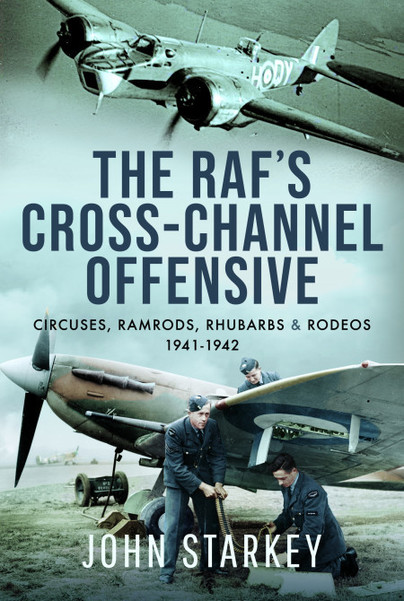Author Guest Post: John Starkey
The RAF’s Cross-Channel Offensive
When I started writing books, in 1985, I was very lucky. In those far off days, I was very much a car enthusiast and this was a period where books on cars were selling reasonably well.
My first book was on the 1956-59 Ferrari 250GT “Tour de France” series of competition Berlinettas, a slim volume, which Haynes Publishing picked up, followed up in 1987 by a book on the racing versions of the Porsche 911, notably from the 1967 S model to the RSR. Again, Haynes published the book.
One of Haynes’ employees, Rod Grainger, left their employ and started up his own company, Veloce Publishing, in Dorset. He invited me to write a “New and improved” version of the Porsche book, which included the individual histories of the cars, and I did. That was it. Since then, I’ve written some twenty plus books on racing cars, at least those which have interested me.
Now we have to backtrack somewhat. I was born in 1944 and growing up had been informed about how we, the British people, had beaten the Germans, not once, but twice. I took a great interest in military history as I grew up and gradually came to the realisation that a lot about the World Wars was not being covered accurately… However, films like “Reach for the Sky” and “The Dam Busters” came out, reinforcing all our prejudices, so all was ok after all.
And then in the 1960s, “The Donkeys” by Alan Clark was published.
From this, I learned that several of our glorious leaders had not been quite so glorious when considering the lives of the men under their command. Think: General Haig. I read many books detailing the air fighting in World War 1, of the Royal Flying Corps, (RFC), which at that time was under the command of then Brigadier General Hugh Trenchard, who seemed to be a real “press on regardless!” type, even if that was with the lives of the men under his command and not him directly…
I began to wonder about who else might fit this description. Oh yes, I read about General Percival and the debacle at Singapore in the Second World War but back then, I was more keen on the Air Force than the army.
As time went by, I began reading accounts of what had happened with RAF Fighter Command and its glorious Spitfires and, to a lesser extent, Hurricanes. Yes! We had won the Battle of Britain but then the narrative had gone suspiciously quiet…
Until, in the 1970s, I bought a book by that great writer, LJK Setright, about the development of the Piston engine for aircraft called “The Power to Fly.” I still have my copy. In that book, I found what I thought was a curious quote: “By the time the Napier Sabre came into service, (October 1941), all too many of the really good pilots of Fighter Command had gone, and those who had taken their place were generally of poorer quality and were given only the most hasty and superficial of training before being sent out to do battle.”
Where had the really good pilots of Fighter Command gone? They couldn’t all have been killed in the Battle of Britain, surely?
At that time it appeared that most of the fighting over occupied France and Germany had been carried out by the Americans, with their flying Fortress and Liberator bombers, escorted by hordes of P-51 Mustangs.
Then, quite by accident, In 1996, I was given a book by an American writer, Donald Caldwell, called ” The JG26 War Diaries.” (Grub Street Publishers).
What an eye opener. This book actually detailed every air combat between the RAF Fighters and the Luftwaffe, with claims and confirmed losses on both sides. It appeared that RAF FIghter Command, under the new management of William Sholto Douglas and Trafford Leigh-Mallory, heading up 11 Group, had sent out Spitfires, closely escorting Blenheim medium bomber raids into France on an almost daily basis in 1941 and 1942. Why? Surely they could see the results of the Battle of Britain, where short range Messerschmitt Bf 109s had closely escorted the German medium bombers, which led to their defeat?
But it appeared that Sholto Douglas and Leigh Mallory had been very keen to prove that their dear fighters could overcome any opposition in this campaign, suggested first of all by the now retired Trenchard. Anyway, there were only two Jagdgeschwaders of German fighters, JG2 and JG26 with, perhaps just 250 aircraft to oppose them. How hard could it be?
It turned out to be very hard. The RAF overclaimed in the order of 5:1. The Messerschmitts, (and later on Focke-Wulf Fw 190s), shot down the Spitfires at the rate of 4:1. The raids were called off at the end of 1942, because of the losses to the RAF, some one thousand pilots.
The leaders of Fighter Command knew the actual losses on both sides. There were ample intelligence reports, both through captured German aircrew and the recently broken Enigma codes to inform them. But somehow those then leaders knew what they were doing was the right thing… Until it wasn’t.
It was an interesting book to write. I spoke to people who knew a lot more than me. People who have restored and flown Spitfires and Messerschmitt Bf 109s and Focke-Wulf 190s. I read over sixty books on the subject. If nothing else, this was a campaign that should never have been carried out, for various reasons, which I have also detailed in the book.

The RAF’s Cross-Channel Offensive is available to order here.

